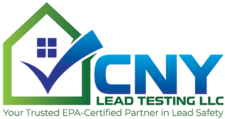Lead Paint Visual Inspection
An Environmental Protection Agency (EPA) Visual Hazard Inspection for lead paint is an evaluation process conducted by a certified lead-based paint inspector or risk assessor to visually assess a residential or child-occupied facility (such as a home, daycare, or school) for the presence of lead-based paint hazards. This type of inspection is a preliminary step in identifying potential lead hazards and determining whether further testing or remediation is necessary. Visual hazard inspections are generally less comprehensive and less invasive than full lead paint inspections or risk assessments but can provide valuable information about the condition of painted surfaces and potential lead hazards.
Here are the key components and steps involved in an EPA Visual Hazard Inspection for lead paint:
- Qualified Inspector: The visual hazard inspection should be conducted by an EPA-certified lead-based paint inspector or risk assessor. These individuals are trained to identify and evaluate potential lead hazards.
- Visual Examination: The inspector visually examines the property, both the interior and exterior, to identify surfaces with deteriorated or damaged paint, as well as friction and impact surfaces that may pose a risk of lead dust generation.
- Identification of Lead-Based Paint: The inspector looks for characteristics of lead-based paint, such as its typical appearance, which can include a chalky or powdery surface, cracking, flaking, or peeling paint, as well as the presence of multiple layers of paint.
- Identification of Potential Hazards: The inspector identifies areas where lead-based paint hazards may exist. This includes assessing whether lead dust or lead-contaminated soil may be present, especially in areas frequented by children.
- Reporting: The inspector provides a report summarizing their findings. This report may include photographs of areas of concern and recommendations for further action if lead hazards are identified.
- Recommendations for Further Testing or Remediation: Based on the visual hazard inspection results, the inspector may recommend more comprehensive testing, such as lead dust wipe sampling or X-ray fluorescence (XRF) testing, to confirm the presence of lead and assess lead levels more accurately. If hazards are confirmed, recommendations for hazard reduction or abatement may also be provided.
It’s important to note that a visual hazard inspection is a relatively quick and non-invasive assessment of potential lead hazards. If lead hazards are suspected or if the property is being renovated or has a history of lead hazards, a more comprehensive lead inspection or risk assessment may be necessary to assess the full extent of lead-based paint hazards and develop a plan for mitigation or abatement.
Property owners, tenants, and homeowners should be aware of the importance of lead-based paint hazard assessment and work with certified inspectors to ensure the safety of occupants, particularly children and pregnant women, who are at higher risk of lead exposure.
